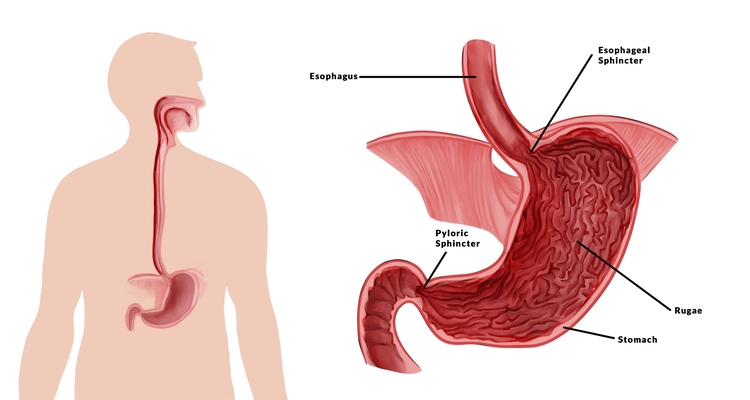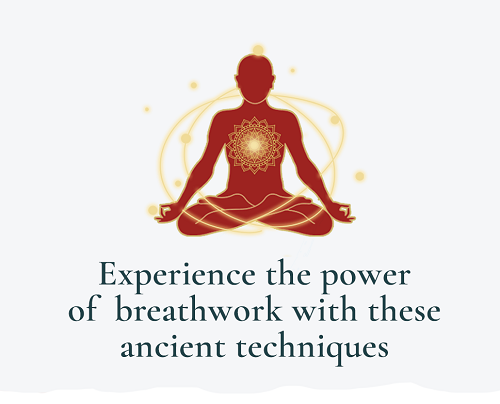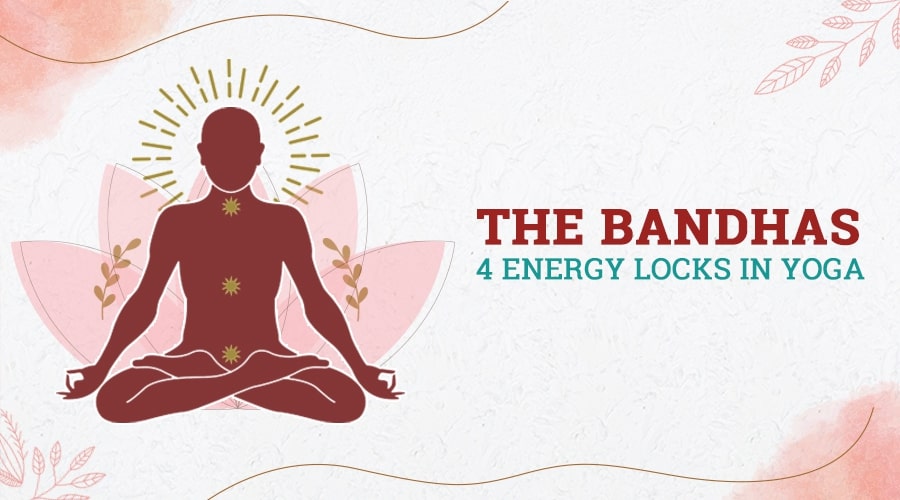In yoga classes or training, you have probably heard about the bandhas, also known as internal energy locks. Many yoga teachers regularly use the phrase ‘activate your bandhas’ in their instructions, but these are rarely explained further. Read on to understand what the 4 main bandhas are in yoga, their benefits, and how to properly activate them in your practice.
What Are Bandhas?

Bandha in Sanskrit means “lock”. The purpose of a bandha is to ‘lock’ the energy flow in a specific part of the body temporarily. When the ‘lock’ is released, the energy flows more vigorously through the body. This promotes overall health and vitality.
On a physical level, a bandha is created when the sphincter and specific muscles in relation to it are contracted. A sphincter is a ring-shaped muscle within the body that relaxes or tightens. This action opens or closes a passage in the body. An example would be within the digestive system where a sphincter regulates the passage of food from the esophagus to the stomach, through the intestines and out the anus. There are over sixty sphincters in the human body.
There are six sphincters in the digestive system. Three of these six sphincters can be contracted to create the bandhas or energy locks:
- Anal sphincter = Mula Bandha
- Sphincter of oddi = Uddiyana Bandha
- Upper esophageal sphincter = Jalandhara Bandha
The combination of these three individual locks forms the fourth bandha, Maha Bandha, also referred to as ‘the great lock.’
What Happens When You Hold a Bandha?
Bandhas in Pranayama
You may be wondering why bandhas are used in the first place. Traditionally bandhas are meant to manipulate prana, life force, within the astral (energy) body. As the physical and astral body are linked and we are more used to manipulating our physical body, we use muscle contractions to create both a physical and energetic lock.
So, bandhas are a way to lock energy and of manipulating prana life force.
Prana governs inhaling and exhaling, thereby giving energy to all physical and mental activity. The correct way to manipulate prana is through the breath. This is what happens in advanced pranayama techniques. Pranayama can literally be translated as the expansion of life force. Breath control, retention, and locks are utilized to manipulate the prana and our body’s ability to retain more prana.
As our ability to retain more life force increases, so does our holistic health and vitality. However, remember that proper (advanced) pranayama should be only practiced in a controlled way with the right intentions and under the guidance of an experienced teacher.
Read more: What is the Difference Between Pranayama and Breathing Exercises?
Bandhas in Yoga Asana Practice
Bandhas have a physical aspect and an energetic aspect. Even though bandhas were traditionally practiced for their energetic benefits, the muscular activation they promote can be useful in asana practice.
Before we understand how the principles of bandhas can be useful in asana practice, there is one important point that we can’t skip: You can’t apply bandhas when you move and breathe!
Therefore, technically, it’s impossible to apply bandhas in asana practice.
Activating certain sphincter muscles during asanas or movements gives better control and stability but that is actually just an activation of the muscle and not the application of bandhas.
A better way to refer to this activation (if we must use the word bandha) is to call it a ‘functional bandha’.
How to Practice the 4 Bandhas
These internal locks might uncomfortable in the beginning so it will take some practice to get used to. Before getting started, find a steady and comfortable sitting position with your spine elongated.
1. Mula Bandha
We practice Mula Bandha with internal or external breath retention. In a comfortable seated position with your mind calm, follow these simple steps to master the Mula Bandha using internal retention:
- Feel supported first; seated and comfortable.
- Imagine you have to urinate and have a bowel movement but you cannot at this moment. The effort of holding in your urine and stool automatically engages your pelvic floor muscles.
- Feel that sensation and get comfortable with activating those muscles.
- To begin the bandha, inhale for 4 counts and hold the muscles for 8 to 12 counts.
- Release the pelvic floor and exhale.
Cautions for the Mula Bandha:
- It is important to remember that you should not overuse or over-contract the pelvic floor muscles. A gentle squeeze is enough.
- Your upper body should be relaxed and steady.
2. Uddiyana Bandha
The Uddiyana Bandha can be practiced in either a sitting or a standing position. While standing, place your hands firmly on the thighs, keep the legs apart, and bend your trunk slightly forward. From a seated position:
- Feel supported first; seated and comfortable.
- Empty the lungs and belly by controlled exhalation. Breathe out till there is no air left in your belly.
- When the lungs and belly are completely empty, suck the navel in and up. Imagine you are sucking up noodles through your lips. By doing this, the diaphragm rises naturally into the thoracic cavity and the abdomen rests against the back of the body, high in the thoracic cavity.
- Now hold your breath and the abdomen gently for 8 to 12 counts.
- Release the abdomen and breathe out.
Cautions for Uddiyana Bandha:
- This bandha must be practiced on an empty stomach.
- Remember that during the retention of this lock you are not breathing; you are practicing the external retention technique, Bahaya Kumbhak (holding the breath out of the body).
- Do not attempt to hold your breath in this position longer than you can do so comfortably without inhaling. It is common to cough a bit.
- Note this bandha can only be applied with external retention. It is not possible to perform this bandha after inhaling (internal retention).
3. Jalandhara Bandha
To practice Jalandhara Bandha with internal retention:
- Feel supported first; seated and comfortable.
- Inhale to fill the lungs to about two-thirds full and retain the breath.
- Drop the chin to the chest while lifting the sternum toward the chin and then exhale.
- If you swallow your saliva, this helps to feel into the bandha.
- Inhale for 4 counts with the tongue flat against the roof of the mouth.
- Release the breath and bring the chin to the original position.
- Exhale and release the bandha .
4. Maha Bandha
When all three locks are applied in external retention it is called Maha Bandha. This is a very powerful lock and should be practiced only when comfortable with the above three locks.

Receive guided pranayama practices for more clarity & energy with master teacher Ram Jain for free
Benefits of Bandhas
Physical Benefits
Stimulates Organs & Muscle Tissue
When the bandhas are applied they activate muscle tissue and stimulate the organs and the glands of the respective region. For example, the application of Mula Bandha activates the pelvic floor muscles. This tones them and improves their functioning. A scientific study conducted in 2017 with 50 women suffering from symptomatic mild pelvic organ prolapse has shown that a regular practice of Mula Bandha during a three-month period helped reduce the severity of symptoms and improve quality of life in patients with a mild degree of prolapse.
Strengthens the Pelvic Floor
Mula means base, foundation. Imagine a diamond shape made up of anus, genitals, and perineum. These muscles are part of the pelvic floor. When these muscles are activated, there is a lifting action.
Pelvic floor muscles are the support system of the internal organs. The pelvic floor muscles together with the respiratory diaphragm above, create the bottom and top of our abdominal cavity. A term often used in yoga is the perineum. However, the muscles of the perineum form the most superficial layer and do not contribute to stabilizing the pelvic floor. The muscle group doing so is the levator ani group, which means "elevators of the anus".
When we engage the levator ani group, the contraction is not limited to the pelvic floor muscles. There is also a corresponding contraction in the lower abdomen. It also helps to stabilize the SI joint and the spine. Therefore, activating the pelvic floor is useful to create more stability and control and is often referred to as "activating Muladhara Bandha".
Engages the Core & Improves Balance
Uddiyana means “flying up.” There is a lift of the diaphragm and strong activation of deeply seated abdominal muscles.
The muscular activation of moving the belly button toward the spine and upward toward the rib cage (as is the action of Uddiyana Bandha) triggers the activation of our psoas. The psoas in turn is a muscle that helps us control our center of gravity.
Now if we think about lifting the legs up into a headstand with control or hopping into a handstand with control, we can observe a similar (yet less pronounced) activation in our abdominals. Especially in Ashtanga Vinyasa-based classes, you might often hear the cue ‘engage Uddiyana bandha’ for moving your body in space with lightness and control.
Energetic Benefits
Bandhas also stimulate the chakras by locking the energy around them. When this happens, prana circulates more efficiently throughout the body. Prana, or life force energy, is vital energy which we need to carry out life activities like digestion, blood circulation, and movement. Therefore, when prana flows properly, it improves the function, regeneration, and healing of the bodily systems which is essential for our physical and mental well-being.
Read more: A Complete Guide to the Seven Chakras
Who Should Avoid Bandhas?
Even though they are very beneficial, in some cases, bandhas can aggravate your condition or illness. You should not attempt to apply the bandhas if:
- You are pregnant
- You have blood pressure disorders
- You have any sort of abdomen illness or condition
- You have intestinal disorders or hernia
- You suffer from any heart disease
- You suffer from anxiety or panic attacks
Common Misconceptions About the Bandhas
Anyone Can Practice Bandhas
To apply bandhas you need a certain amount of mental and physical control. Traditionally bandhas were only taught to students with good regular practice.
Bandhas Can Do No Harm
Like any other exercise when not done properly, bandhas can also give adverse effects. There they should be learned and practiced under the proper supervision of a competent teacher.
You Need to Use Force to Apply Bandhas
Actually, once you understand bandhas become very subtle and gentle. You should not feel any extra stress when applying them. If you are using too much force and extra muscle contraction, chances are that you are doing them incorrectly.
Final Thought
When performed correctly, bandhas can use prana and chakras to benefit the body and mind. This makes the bandhas a useful tool to gain optimal health and vitality. There are physical and energetic aspects to bandhas and so it is very important that they are practiced under the guidance of an experienced and knowledgeable teacher. Practicing the bandhas should always be done with caution and patience.

Receive guided pranayama practices for more clarity & energy with master teacher Ram Jain for free

